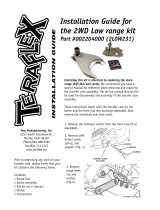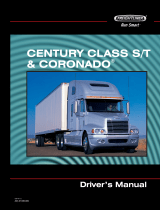
Section 01: Engine
Note: Cruise control system will not accept
speed settings, nor will the "Resume" switch
operate below 20 mph (32 km/h) and the
engine speed must be above 1100 RPM.
3. Cruise Resume: Each time this switch is
actuated, the speed will be increased by 2 mph
(3,5 km/h). This switch allows the driver return
to the last regulated speed following a brake or
"DECEL" switch application.
Note: On-off switch must be in the "ON"
position in order to return to the last regulated
speed.
4. Cruise Decel: Will cancel the cruise
temporarily like a brake application but without
actuating brake light. Set speed is still in
memory for resume.
For additional information, see your "Operator's
Manual"
3.4 Diagnostic System
Accessories (DSA)
The DDEC III engine Diagnostic System
Accessories include the following:
• Check Engine warning light;
• Stop Engine warning light;
• Stop Engine Override switch; and
• Diagnostic Data Link (DDL) connectors.
1. Check Engine Warning Light: This
light, mounted on the central
dashboard panel, illuminates to
indicate that a problem is currently
being detected and that a code has
been stored in the ECM memory. This
light also has a 5-second bulb check
when the ignition is first turned on. The
Check Engine Light illuminates when
the temperature at coolant sensors
exceeds 217°F (103°C) and the
temperature at oil sensors exceeds
260°F (127°C). When sensors reach
those temperatures, engine power
starts to decrease linearly.
2. Stop Engine Warning Light: This
light, also mounted on the central
dashboard panel, illuminates to indica-
te that a major engine problem is
occurring (with the exception of a 5-
second bulb check when the ignition is
first turned on). The Stop Engine Light
illuminates when temperature at coo-
lant sensors exceeds 222°F (106°C)
and the temperature at oil sensors
exceeds 239°F (115°C). When sensors
reach those temperatures, the engine
will shut down after 30 seconds. This
30-second delay period may be
repeated using the OVERRIDE switch.
Note: Once engine is stopped, it can not be
restarted until the malfunction is corrected.
3. Stop Engine OVERRIDE Switch: This
switch, mounted on the L.H. lower
control panel, is used when the Stop
engine warning light is illuminated.
Push down the switch to allow a 30-
second delay period (non cumulative)
in the shutdown procedure. This swicth
can be repeatedly depressed, i.e. one
(1) pulse is sufficient for each 30
second period, in order to move the
vehicle out of traffic.
Note: The stop engine override switch will be
operative only if it has been depressed before the
end of the 30 second delay period.
Caution: The OVERRIDE switch must be used
only in emergency cases, such as to move the
vehicle out of traffic. Excessive use of this switch
could cause serious damage to the engine.
4. Diagnostic Data Link (DDL)
Connectors: A connector is mounted
on the L.H. Lower Control Panel.
Another connector is located in the
rear electric compartment. They allow
to connect the Diagnostic Data Reader
(DDR) and to read the codes or to
access pertinent data on the engine
condition. This enables a more
complete analysis of any defect found
in the DDEC system operation. For
more information, see Detroit Diesel
Troubleshooting Guide #6SE492.



































